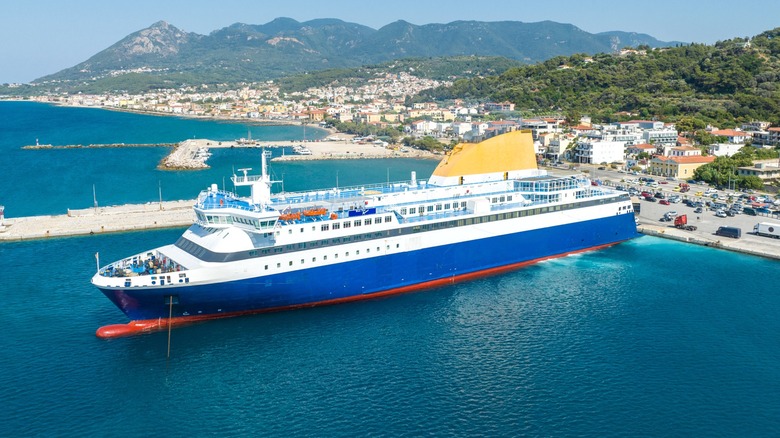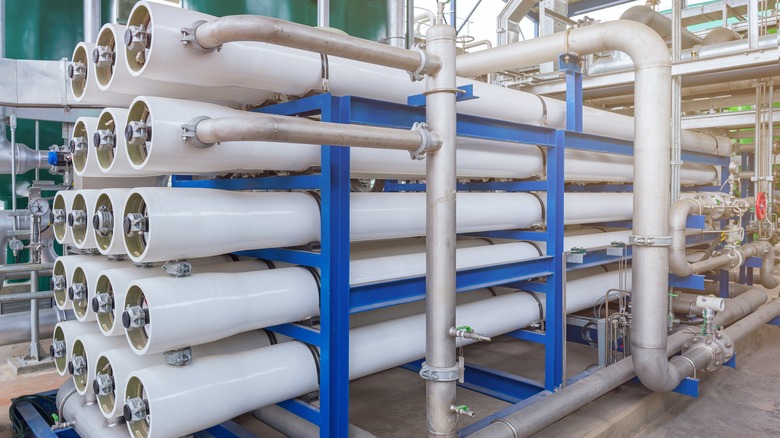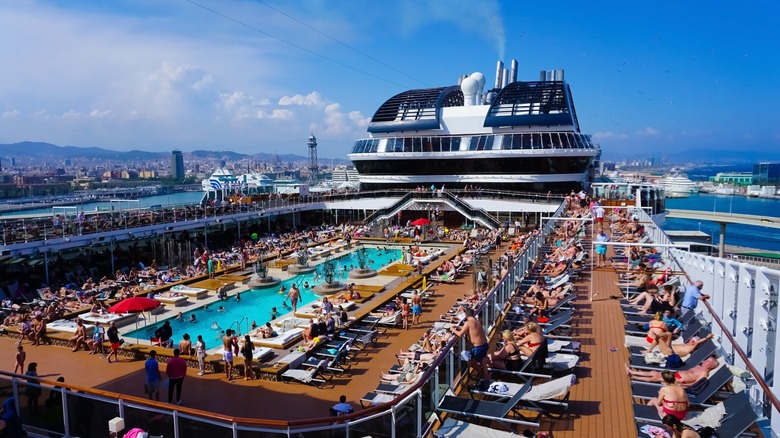The Unexpected Type Of Water You May Not Realize You're Drinking While On A Cruise
When you're relaxing on the high seas with iced refreshing water in hand and the sounds of crashing waves lulling you into a much-needed peace, it's easy to forget about all the questions you may still have about the cruising experience. Is there enough food for everyone? What if a storm hits? How many bottles of rum can you get through customs? They may try to break your calm, but the scent of salty oceanic air blows them away. Then, you bring the glass to your lips, and as the chilled aqua quenches your thirst, you have a pressing thought — how is there tap water on the cruise ship, and how does it not run out?
These massive, illustrious vessels are true wonders of science, capable of carrying thousands of people across rough waters while dishing out daily entertainment, fine dining, and large buffets. Surely, there must be a massive tank of fresh drinking water, right? Technically, yes, there are water tanks aboard most cruise ships. Some have containers large enough to store nearly 500,000 gallons of water. The catch is that you don't drink from those tanks. While it's not universal across all cruise ships, the water already on the vessel (and refilled at some ports) is used for all other purposes besides quenching your thirst. Your drinking water is desalinated, and it typically comes from a much more abundant source: The very ocean you're traveling across.
If it's seawater, why is it not salty?
The notion that you shouldn't drink seawater can be confusing. After all, it's water, which your body craves, and filled with salt, a common seasoning. However, the problem isn't so much the presence of sodium but the amount. Oceanic waters contain over three times the amount of sodium in our blood, and our kidneys can only dissolve so much of it. Excess salt that can't be filtered builds up in your bloodstream. The short-term effect is dehydration. Over longer periods, excess sodium can lead to heart and kidney disease.
That sounds pretty scary, but before you rush to purchase the drink package, enjoying a cold glass of water is perfectly safe on a cruise. Despite being seawater, the H20 in that cup underwent one of two processes to remove the excess sodium, making the tap water safe to drink. According to Royal Caribbean, seawater is first boiled by steam and heat from the ship's engines. Per Jennifer Chu of MIT News, this "drives water to evaporate, leaving salt behind." Chu then explains that "the resulting water vapor can then be condensed and collected as pure, drinkable water."
The secondary method is reverse osmosis. "Instead of using heat, reverse osmosis uses an even lower-energy method to push saltwater through microscopic membranes," Royal Caribbean notes. According to the cruise provider's environmental programs expert, Nick Rose, the membrane is "so small, only clean water can get through."
What happens to all the used water on a cruise ship?
Drinking water isn't the only aqua on a cruise ship. Toilets are flushed, hands are washed, and laundry is run. Thankfully, you already know you're not drinking used water, but what does a cruise ship do to prevent dumping thousands of gallons of waste into the ocean? If you're concerned about eco-friendly travel, you can relax a little — wastewater is not a cruise ship's biggest impact on the environment.
When a cruise ship at sea, wastewater treatment and disposal is an important process. Typically, there are two ways that waste is handled on the water: It's either stored in tanks and emptied into local storage systems when docked, or processed and dumped a specific distance from land. In an interview with Matador Network, Virgin Voyages' sustainability program manager, Sarah Dwyer, stated that sewage and liquid waste "is held on board and then discharged at distances greater than three nautical miles from shore."
How water is handled before disposal depends on the type. For example, black water (which contains human waste) undergoes mechanical, biological, and chemical treatments. A filtration system introduces it to microorganisms that further dispose of organic matter before it undergoes a sifting process to remove the organisms. Nitrogen and phosphorus are introduced in the final step before they're disposed of. Virtually all water that may be contaminated in any way runs through a filtration process to make it safer for the sea.


